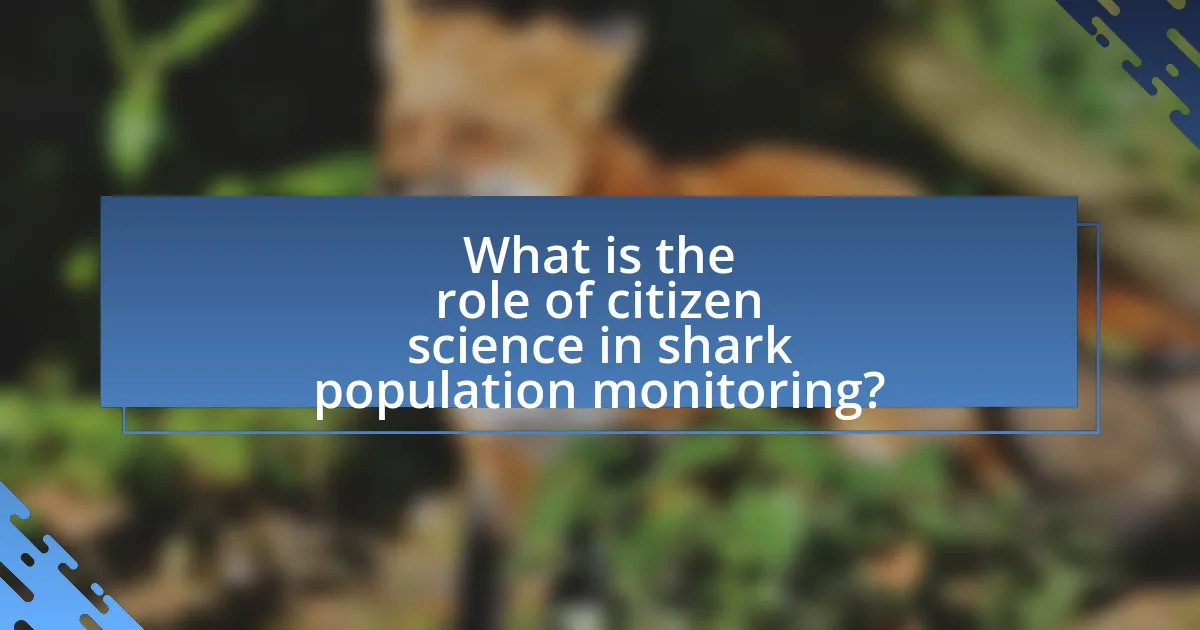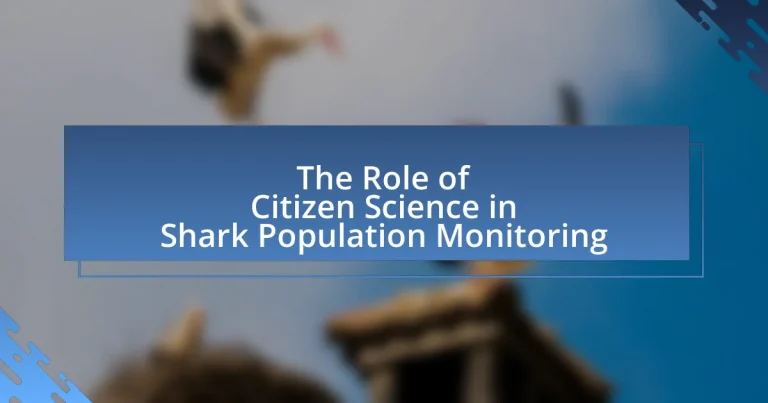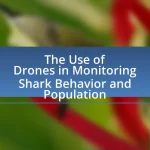Citizen science is a vital component in shark population monitoring, engaging the public in data collection and observation to enhance research efforts. Programs like the Shark Trust’s “Shark Spotters” utilize volunteers to report shark sightings, contributing to a comprehensive understanding of species distribution and abundance. This article explores the methods employed by citizen scientists, the validation of collected data, and the ecological significance of monitoring shark populations. It also highlights successful citizen science initiatives, the challenges faced by participants, and the potential for future advancements in marine research through technology and policy support.

What is the role of citizen science in shark population monitoring?
Citizen science plays a crucial role in shark population monitoring by engaging the public in data collection and observation efforts. This involvement allows researchers to gather extensive data across vast geographic areas, which would be challenging to achieve through traditional scientific methods alone. For instance, initiatives like the Shark Trust’s “Shark Spotters” program have successfully utilized volunteers to report shark sightings, contributing valuable information on species distribution and abundance. Such collaborative efforts enhance the understanding of shark populations and inform conservation strategies, demonstrating the effectiveness of citizen science in marine research.
How does citizen science contribute to understanding shark populations?
Citizen science significantly contributes to understanding shark populations by enabling non-experts to collect and report data on shark sightings and behaviors. This widespread participation increases the volume of data available for researchers, allowing for more comprehensive assessments of shark distribution, abundance, and ecological roles. For instance, projects like the Shark Spotters program in South Africa have utilized citizen reports to track shark movements and inform beach safety, demonstrating the effectiveness of community involvement in scientific research. Additionally, studies have shown that citizen-collected data can complement traditional research methods, leading to more robust population models and conservation strategies.
What methods do citizen scientists use to collect data on sharks?
Citizen scientists collect data on sharks primarily through methods such as visual surveys, tagging, and reporting sightings. Visual surveys involve observing and recording shark species and behaviors during dives or boat trips, which helps in understanding population distribution. Tagging methods, including the use of satellite tags or acoustic tags, allow citizen scientists to track shark movements and gather data on their migratory patterns. Additionally, citizen scientists often report shark sightings through platforms like iNaturalist or SharkLogger, contributing valuable information to databases that researchers use for population monitoring and conservation efforts. These methods collectively enhance the understanding of shark populations and their habitats, supporting ongoing research and conservation initiatives.
How is the data collected by citizen scientists validated?
Data collected by citizen scientists is validated through a combination of peer review, comparison with established datasets, and statistical analysis. Peer review involves experts evaluating the methodologies and findings to ensure accuracy and reliability. Comparison with established datasets allows researchers to assess the consistency of citizen-collected data with previously verified information. Statistical analysis further helps in identifying anomalies and confirming the validity of the data. These methods collectively enhance the credibility of citizen science contributions to shark population monitoring.
Why is shark population monitoring important?
Shark population monitoring is important because it provides critical data for the conservation and management of shark species, which are vital to marine ecosystems. Monitoring helps identify population trends, assess the health of shark populations, and inform policy decisions aimed at protecting these species. For instance, studies have shown that overfishing has led to significant declines in shark populations, with some species experiencing reductions of over 90% in their numbers. This data is essential for implementing effective conservation strategies and ensuring the sustainability of marine biodiversity.
What are the ecological impacts of declining shark populations?
Declining shark populations lead to significant ecological impacts, primarily disrupting marine ecosystems. Sharks are apex predators, and their reduction can result in the overpopulation of prey species, which in turn affects the entire food web. For instance, studies have shown that the decline of sharks in certain regions has led to an increase in smaller predatory fish, which then overconsume herbivorous fish, ultimately harming coral reef health by allowing algae to proliferate unchecked. This phenomenon has been documented in various marine environments, highlighting the critical role sharks play in maintaining ecological balance.
How do sharks contribute to marine ecosystems?
Sharks contribute to marine ecosystems primarily as apex predators, helping to maintain the balance of marine life. By preying on various species, sharks regulate fish populations, which in turn supports the health of coral reefs and other habitats. For instance, studies have shown that the decline of shark populations can lead to an overabundance of smaller fish species, which can disrupt the entire ecosystem. This trophic cascade illustrates the critical role sharks play in preserving biodiversity and ecosystem stability.

What are the benefits of involving citizens in shark population monitoring?
Involving citizens in shark population monitoring enhances data collection, increases public awareness, and fosters community engagement. Citizen participation allows for the gathering of extensive data across diverse geographic areas, which is crucial for understanding shark populations. For instance, studies have shown that citizen science initiatives can significantly increase the volume of data collected, as seen in the Shark Trust’s citizen science projects, which have documented thousands of shark sightings. Additionally, engaging citizens raises awareness about shark conservation, leading to more informed communities that support protective measures. This involvement also cultivates a sense of stewardship, encouraging individuals to take an active role in marine conservation efforts.
How does citizen engagement enhance data collection efforts?
Citizen engagement enhances data collection efforts by increasing the volume and diversity of data gathered from various sources. Engaged citizens contribute local knowledge and observations, which can lead to more comprehensive datasets. For instance, in shark population monitoring, citizen scientists can report sightings and behaviors, providing real-time data that researchers may not capture through traditional methods. Studies have shown that citizen-collected data can match the accuracy of professional data in ecological research, thereby validating the effectiveness of citizen engagement in enhancing data collection.
What are the advantages of having a larger pool of observers?
Having a larger pool of observers enhances data collection and improves the accuracy of findings in shark population monitoring. This increased number of observers allows for more extensive geographic coverage, leading to a higher likelihood of encountering diverse shark species and behaviors. Additionally, a larger observer base can contribute to a more robust dataset, reducing biases and increasing the reliability of the results. Studies have shown that citizen science initiatives, such as those involving numerous volunteers, can yield data comparable in quality to that collected by professional scientists, thereby validating the effectiveness of a larger observer pool in ecological research.
How does citizen science foster community awareness and education?
Citizen science fosters community awareness and education by actively involving local residents in scientific research, particularly in monitoring shark populations. This engagement allows community members to gain firsthand knowledge about marine ecosystems, the importance of sharks, and conservation efforts. Studies have shown that when individuals participate in data collection and analysis, their understanding of ecological issues increases significantly, leading to heightened awareness and advocacy for marine conservation. For example, programs like the Shark Trust’s citizen science initiatives have demonstrated that participants not only learn about shark biology and behavior but also become more invested in protecting their local marine environments.
What challenges do citizen scientists face in shark monitoring?
Citizen scientists face several challenges in shark monitoring, including limited training, data accuracy concerns, and logistical issues. Limited training can hinder their ability to correctly identify species and collect reliable data, as many citizen scientists may lack formal education in marine biology. Data accuracy concerns arise from the potential for misidentification or inconsistent data collection methods, which can compromise the integrity of the research. Logistical issues, such as access to monitoring sites and the need for specialized equipment, can also pose significant barriers to effective participation in shark monitoring initiatives. These challenges can ultimately affect the overall success and reliability of citizen science projects focused on shark populations.
What are the common obstacles in data collection and reporting?
Common obstacles in data collection and reporting include lack of standardization, limited access to technology, and participant bias. Lack of standardization in data collection methods can lead to inconsistencies, making it difficult to compare results across different studies. Limited access to technology, particularly in remote areas, can hinder the ability of citizen scientists to gather and report data effectively. Additionally, participant bias may occur when individuals have preconceived notions about shark populations, which can skew the data collected. These challenges can significantly impact the reliability and validity of data in shark population monitoring efforts.
How can citizen scientists overcome these challenges?
Citizen scientists can overcome challenges in shark population monitoring by utilizing structured training programs and leveraging technology for data collection. Structured training equips citizen scientists with essential skills and knowledge, ensuring they understand the methodologies and protocols necessary for accurate data gathering. For instance, organizations like the Ocean Conservancy provide workshops that enhance participants’ understanding of marine ecosystems and data collection techniques. Additionally, technology such as mobile apps and online platforms facilitates real-time data entry and sharing, which streamlines the monitoring process and enhances collaboration among citizen scientists. This combination of training and technology not only improves data quality but also fosters a sense of community and shared purpose among participants, ultimately contributing to more effective shark population monitoring efforts.

What are some successful examples of citizen science in shark monitoring?
Successful examples of citizen science in shark monitoring include the Shark Spotters program in South Africa and the Ocearch project. The Shark Spotters program engages local communities to identify and report shark sightings, contributing to a database that enhances public safety and informs conservation efforts. This initiative has documented over 1,000 shark sightings since its inception in 2004, providing valuable data on shark behavior and distribution. Similarly, the Ocearch project utilizes citizen scientists to tag and track sharks, allowing for real-time data collection on their movements. This project has successfully tagged over 400 sharks, generating critical information for understanding shark migration patterns and population dynamics. Both initiatives demonstrate the effectiveness of citizen involvement in gathering essential data for shark conservation and monitoring.
How have specific projects utilized citizen science for shark research?
Specific projects have utilized citizen science for shark research by engaging the public in data collection and monitoring efforts. For instance, the “Shark Spotters” program in South Africa trains volunteers to identify and report shark sightings, contributing valuable data on shark populations and behavior. Additionally, the “Shark Research and Conservation Program” at the University of Miami involves citizen scientists in tagging and tracking sharks, which helps researchers gather critical information on migration patterns and population dynamics. These initiatives demonstrate the effectiveness of citizen involvement in enhancing scientific understanding of shark populations, as evidenced by the substantial data collected that informs conservation strategies.
What outcomes have been achieved through these citizen science initiatives?
Citizen science initiatives in shark population monitoring have led to significant outcomes, including enhanced data collection on shark populations and increased public awareness about marine conservation. These initiatives have resulted in the gathering of thousands of sightings and biological data points, which have been crucial for understanding species distribution and abundance. For instance, the “Shark Spotters” program in South Africa has successfully documented over 1,000 shark sightings, contributing to improved safety measures and conservation strategies. Additionally, citizen engagement has fostered a greater appreciation for marine ecosystems, as evidenced by surveys indicating that participants report increased knowledge and concern for shark conservation.
How do these projects demonstrate the effectiveness of citizen involvement?
Citizen involvement in shark population monitoring projects demonstrates effectiveness through increased data collection and community engagement. These projects leverage the participation of local citizens to gather extensive data on shark sightings and behaviors, which enhances the overall understanding of shark populations. For instance, initiatives like the Shark Trust’s citizen science programs have successfully mobilized volunteers to report shark sightings, resulting in a significant increase in data points that researchers can analyze. This collaborative approach not only enriches scientific research but also fosters a sense of stewardship among participants, leading to greater public awareness and advocacy for shark conservation.
What future directions can citizen science take in shark population monitoring?
Citizen science can enhance shark population monitoring through the integration of advanced technology, community engagement, and data sharing. By utilizing smartphone applications and online platforms, citizen scientists can collect and report data on shark sightings, which can be aggregated to provide real-time insights into population dynamics. Studies, such as those conducted by the Ocean Conservancy, demonstrate that community-driven data collection can significantly contribute to understanding species distribution and behavior patterns. Furthermore, partnerships between researchers and local communities can foster educational initiatives that raise awareness about shark conservation, ultimately leading to more robust data collection efforts and improved management strategies.
How can technology enhance citizen science efforts in marine research?
Technology can enhance citizen science efforts in marine research by providing tools for data collection, analysis, and communication. For instance, mobile applications enable citizen scientists to record and share observations of marine species, including sharks, in real-time. These applications often include features such as GPS tracking and photo uploads, which facilitate accurate data gathering. Additionally, remote sensing technologies, like drones and underwater cameras, allow for the monitoring of marine environments without disturbing wildlife. Research shows that citizen science initiatives utilizing technology can significantly increase data volume and quality; a study published in the journal “Frontiers in Ecology and the Environment” found that citizen-collected data on shark populations can match the accuracy of professional research when proper training and tools are provided. Thus, technology not only streamlines the process of data collection but also enhances the reliability of the information gathered in marine research.
What role can policy play in supporting citizen science initiatives?
Policy can play a crucial role in supporting citizen science initiatives by providing funding, establishing regulatory frameworks, and promoting collaboration between governmental agencies and community members. Effective policies can allocate resources for training citizen scientists, ensuring data quality, and integrating citizen-collected data into official research and conservation efforts. For instance, the National Oceanic and Atmospheric Administration (NOAA) has implemented policies that encourage public participation in marine monitoring, which enhances data collection on shark populations. Such policies not only empower citizens but also enhance the scientific understanding of biodiversity and ecosystem health.
What best practices should citizen scientists follow for effective shark monitoring?
Citizen scientists should follow systematic data collection, accurate species identification, and adherence to ethical guidelines for effective shark monitoring. Systematic data collection involves using standardized methods to record shark sightings, including location, time, and environmental conditions, which enhances the reliability of the data. Accurate species identification is crucial, as misidentification can lead to incorrect conclusions about shark populations; utilizing field guides or apps can aid in this process. Ethical guidelines, such as minimizing disturbance to sharks and their habitats, ensure that monitoring efforts do not negatively impact the species or ecosystem. These practices are supported by studies indicating that structured citizen science initiatives can significantly contribute to marine conservation efforts, as seen in the “Shark Spotters” program in South Africa, which effectively engages the public in monitoring shark populations while promoting safety and awareness.


